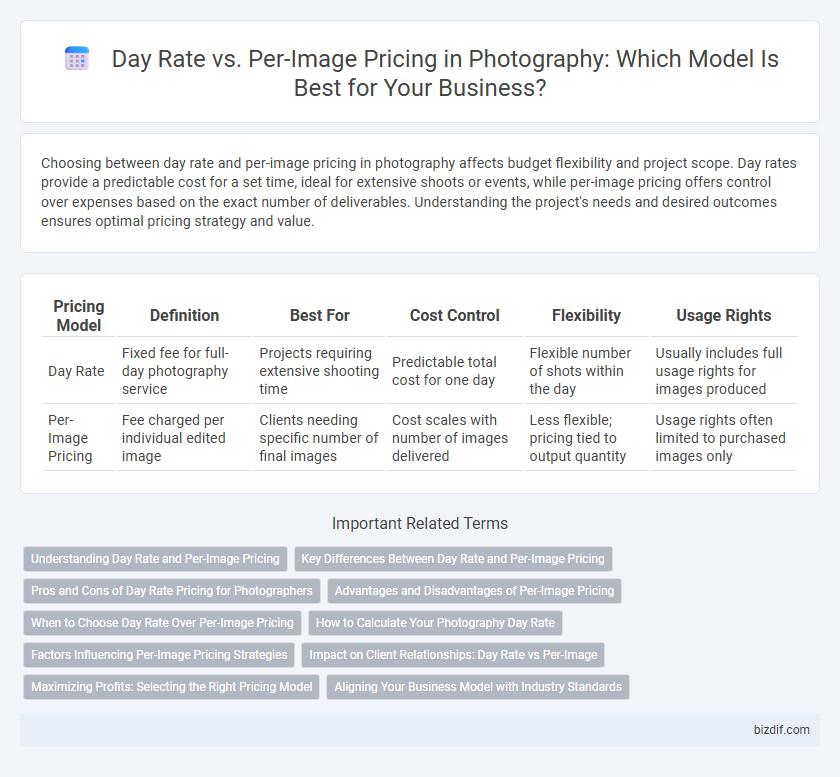Choosing between day rate and per-image pricing in photography affects budget flexibility and project scope. Day rates provide a predictable cost for a set time, ideal for extensive shoots or events, while per-image pricing offers control over expenses based on the exact number of deliverables. Understanding the project's needs and desired outcomes ensures optimal pricing strategy and value.
Table of Comparison
| Pricing Model | Definition | Best For | Cost Control | Flexibility | Usage Rights |
|---|---|---|---|---|---|
| Day Rate | Fixed fee for full-day photography service | Projects requiring extensive shooting time | Predictable total cost for one day | Flexible number of shots within the day | Usually includes full usage rights for images produced |
| Per-Image Pricing | Fee charged per individual edited image | Clients needing specific number of final images | Cost scales with number of images delivered | Less flexible; pricing tied to output quantity | Usage rights often limited to purchased images only |
Understanding Day Rate and Per-Image Pricing
Day rate pricing in photography charges clients a fixed fee for an entire day of service, covering shooting time, setup, and post-processing. Per-image pricing, on the other hand, bills clients based on the number of edited images delivered, which can vary significantly depending on client needs and usage rights. Understanding these pricing models helps photographers tailor their rates to project scope, client budget, and licensing requirements effectively.
Key Differences Between Day Rate and Per-Image Pricing
Day rate pricing offers a fixed fee for an entire shoot, providing predictability and often including unlimited images within that timeframe. Per-image pricing charges clients based on the number of photos delivered, ensuring cost aligns directly with the quantity and quality of images received. Key differences include flexibility in budget management, potential for higher overall cost with per-image pricing, and streamlined billing with day rates.
Pros and Cons of Day Rate Pricing for Photographers
Day rate pricing offers photographers a predictable income and simplifies client billing by covering all deliverables within a fixed time frame, which can enhance cash flow stability. However, it may limit earning potential on projects that require extensive post-production or result in fewer final images, potentially causing dissatisfaction for clients seeking a higher volume of photos. This model suits commercial and event photographers who prioritize efficiency and time management but requires careful scope definition to avoid scope creep and ensure profitability.
Advantages and Disadvantages of Per-Image Pricing
Per-image pricing offers clear advantages such as precise cost control and payment only for selected shots, which benefits clients with specific image needs. However, it can lead to higher overall expenses if many images are required, and it may limit creative flexibility for photographers who need to experiment and capture varied shots. This pricing model often complicates budgeting and project scope management compared to the predictable costs of day rate pricing.
When to Choose Day Rate Over Per-Image Pricing
Choose a day rate pricing model when a photography project requires extensive shooting hours, multiple locations, or unpredictable schedules to ensure consistent compensation regardless of the number of images captured. Day rates are ideal for commercial shoots, events, or assignments where the client expects comprehensive coverage and collaboration throughout the day. This approach provides photographers with financial stability and encourages creative flexibility without the pressure of limiting image counts.
How to Calculate Your Photography Day Rate
Calculating your photography day rate involves assessing your total working hours, including shoot time, travel, setup, and post-processing. Factor in your desired annual income, business expenses, taxes, and equipment costs to determine an hourly rate, then multiply by the total billable hours in a typical workday. Comparing this day rate to per-image pricing helps photographers balance predictable income with pricing flexibility based on project complexity.
Factors Influencing Per-Image Pricing Strategies
Per-image pricing strategies in photography are influenced by factors such as image complexity, post-processing requirements, usage rights, and client industry standards. Detailed retouching or specialized shooting conditions often increase per-image fees, while broader usage licenses can significantly impact pricing tiers. Photographers must balance the time invested, market demand, and the potential value of each image when determining per-image rates.
Impact on Client Relationships: Day Rate vs Per-Image
Day rate pricing fosters stronger client relationships by providing predictable costs, encouraging collaboration and trust throughout the project. Per-image pricing can lead to tension as clients may focus on quantity over quality, potentially limiting creative freedom. Transparent communication about pricing structures enhances client satisfaction and long-term partnerships in photography services.
Maximizing Profits: Selecting the Right Pricing Model
Choosing between day rate and per-image pricing significantly impacts a photographer's profitability and client satisfaction. Day rate pricing offers predictable income and encourages clients to book longer sessions, while per-image pricing maximizes revenue on high-demand projects with extensive editing and retouching. Analyzing project scope, client expectations, and post-processing time helps photographers select the optimal model to enhance earnings and streamline workflow.
Aligning Your Business Model with Industry Standards
Day rate pricing in photography offers clients a predictable, lump-sum cost for full-day sessions, streamlining budgeting and scheduling. Per-image pricing aligns costs directly with deliverables, incentivizing efficiency and catering to projects requiring selective image usage. Aligning your business model with industry standards involves analyzing client preferences, regional market rates, and project scope to balance competitiveness and profitability.
Day Rate vs Per-Image Pricing Infographic

 bizdif.com
bizdif.com